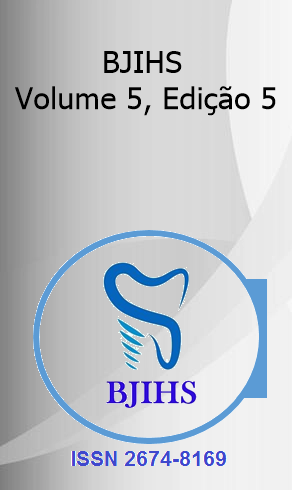Abstract
This article aims to identify and analyze the epidemiological profile of congenital syphilis in Brazil, from 2017 to 2021. This article is an epidemiological, retrospective, descriptive study on cases of congenital syphilis in Brazil and its regions, with data obtained from the Notifiable Diseases Information System (SINAN), between 2017 and 2021. The variables of interest were: age group of the newborn, sex, ethnicity, region, education and maternal age group, completion of pre- -natal, maternal syphilis, partner treatment and evolution of cases. It was found that in the period from 2017 to 2021, 109,737 cases of congenital syphilis were recorded. During this period, the year 2018 was responsible for the majority of case numbers, followed by a decline until the year 2021. The results of this study highlight a high rate of occurrence of congenital syphilis in the country. However, it is crucial to highlight the limitations of the data presented, due to the significant underreporting of cases. Therefore, it is essential to structure and implement actions to control this disease and improve its reporting. Congenital syphilis is a preventable condition, but its consequences are numerous, especially for the fetus.
References
ALEEM, S. et al. Severe Congenital Syphilis in the Neonatal Intensive Care Unit: A Retrospective Case Series. The Pediatric Infectious Disease Journal, v. 41, n. 4, p. 335–339, 1 abr. 2022.
ALMEIDA, A. S. DE et al. Sífilis na gestação, fatores associados à sífilis congênita e condições do recém-nascido ao nascer. Texto & Contexto - Enfermagem, v. 30, p. e20200423, 16 ago. 2021.
CHURCH, S. J.; WILLIS, S.; JNAH, A. J. Congenital Syphilis Infection: A Case Study. Neonatal Network, v. 42, n. 3, p. 156–164, 1 maio 2023.
COOPER, J. M.; SÁNCHEZ, P. J. Congenital syphilis. Seminars in Perinatology, v. 42, n. 3, p. 176–184, abr. 2018.
DATASUS – Ministério da Saúde. Disponível em: <https://datasus.saude.gov.br/>. Acesso em: 12 out. 2023.
GALVIS, A. E.; ARRIETA, A. Congenital Syphilis: A U.S. Perspective. Children, v. 7, n. 11, 29 out. 2020.
GARCIA, L. N. et al. Congenital syphilis in Argentina: Experience in a pediatric hospital. PLOS Neglected Tropical Diseases, v. 15, n. 1, p. e0009010, 6 jan. 2021.
HUSSAIN, S. A.; VAIDYA, R. Congenital Syphilis. Disponível em: <https://www.ncbi.nlm.nih.gov/books/NBK537087/>.
KEUNING, M. W. et al. Congenital syphilis, the great imitator—case report and review. The Lancet Infectious Diseases, v. 20, n. 7, p. e173–e179, 1 jul. 2020.
KIMBALL, A. et al. Missed Opportunities for Prevention of Congenital Syphilis — United States, 2018. MMWR. Morbidity and Mortality Weekly Report, v. 69, n. 22, p. 661–665, 5 jun. 2020.
MASCHIO-LIMA, T. et al. Epidemiological profile of patients with congenital and gestational syphilis in a city in the State of São Paulo, Brazil. Revista Brasileira de Saúde Materno Infantil, v. 19, n. 4, p. 865–872, dez. 2019.
MEDRONHO, R. Epidemiologia. 2ª edição. São Paulo, 2009.
ROCHA, A. F. B. et al. Complications, clinical manifestations of congenital syphilis, and aspects related to its prevention: an integrative review. Revista Brasileira de Enfermagem, v. 74, n. 4, 14 jul. 2021.
RODRÍGUEZ-CERDEIRA, C.; SILAMI-LOPES, V. G. Sífilis congénita en el siglo xxi. Actas Dermo-Sifiliográficas, v. 103, n. 8, p. 679–693, 1 out. 2012.
ROWE, C. R.; NEWBERRY, D. M.; JNAH, A. J. Congenital Syphilis. Advances in Neonatal Care, v. 18, n. 6, p. 438–445, dez. 2018.
SLUTSKER, J. S.; HENNESSY, R. R.; SCHILLINGER, J. A. Factors Contributing to Congenital Syphilis Cases — New York City, 2010–2016. MMWR. Morbidity and Mortality Weekly Report, v. 67, n. 39, p. 1088–1093, 5 out. 2018.

This work is licensed under a Creative Commons Attribution 4.0 International License.
Copyright (c) 2023 Jhyeniffer Domingos Costa, Luciano da Silva Alves, Julio Alberto Aldana Quiala, Marcos Antônio Muniz de Paula, Yoandy Rivero Ramos, Gabriel Porciúncula Teixeira Basto, Laís Bezerra Perrusi, Juan Carlos Fernández Cordoves, Marcos Furtado Mendonça, Maria Claumyrla Lima Castro
